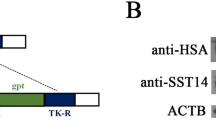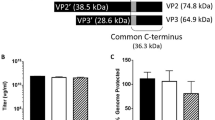Abstract
We have previously described the oncolytic adenovirus, Ad(CgA-E1A-miR122), herein denoted Ad5(CgA-E1A-miR122) that selectively replicates in and kills neuroendocrine cells, including freshly isolated midgut carcinoid cells from liver metastases. Ad5(CgA-E1A-miR122) is based on human adenovirus serotype 5 (Ad5) and infects target cells by binding to the coxsackie-adenovirus receptor (CAR) and integrins on the cell surface. Some neuroendocrine tumor (NET) and neuroblastoma cells express low levels of CAR and are therefore poorly transduced by Ad5. However, they often express high levels of somatostatin receptors (SSTRs). Therefore, we introduced cyclic peptides, which contain four amino acids (FWKT) and mimic the binding site for SSTRs in the virus fiber knob. We show that FWKT-modified Ad5 binds to SSTR2 on NET cells and transduces midgut carcinoid cells from liver metastases about 3–4 times better than non-modified Ad5. Moreover, FWKT-modified Ad5 overcomes neutralization in an ex vivo human blood loop model to greater extent than Ad5, indicating that fiber knob modification may prolong the systemic circulation time. We conclude that modification of adenovirus with the FWKT motif may be beneficial for NET therapy.
This is a preview of subscription content, access via your institution
Access options
Subscribe to this journal
Receive 12 print issues and online access
$259.00 per year
only $21.58 per issue
Buy this article
- Purchase on Springer Link
- Instant access to full article PDF
Prices may be subject to local taxes which are calculated during checkout





Similar content being viewed by others
References
Gustafsson BI, Kidd M, Modlin IM . Neuroendocrine tumors of the diffuse neuroendocrine system. Curr Opin Oncol 2008; 20: 1–12.
Oberg K, Kvols L, Caplin M, Delle Fave G, de Herder W, Rindi G et al. Consensus report on the use of somatostatin analogs for the management of neuroendocrine tumors of the gastroenteropancreatic system. Ann Oncol 2004; 15: 966–973.
Kumar U, Grant M . Somatostatin and somatostatin receptors. Results Probl Cell Differ 2009; 50: 137–184.
Wright RM, Gram H, Vattay A, Byme S, Lake P, Dottavio D et al. Binding epitope of somatostatin defined by phage-displayed peptide libraries. Biotechnology (NY) 1995; 13: 165–169.
Zou Y, Xiao X, Li Y, Zhou T . Somatostatin analogues inhibit cancer cell proliferation in an SSTR2-dependent manner via both cytostatic and cytotoxic pathways. Oncol Rep 2009; 21: 379–386.
Howman-Giles R, Shaw PJ, Uren RF, Chung DK . Neuroblastoma and other neuroendocrine tumors. Semin Nucl Med 2007; 37: 286–302.
Pashankar FD, O’orisio MS, Menda Y . MIBG and somatostatin receptor analogs in children: current concepts on diagnostic and therapeutic use. J Nucl Med 2005; 46 (Suppl 1): 55S–61S.
Toth K, Dhar D, Wold WS . Oncolytic (replication-competent) adenoviruses as anticancer agents. Expert Opin Biol Ther 2010; 10: 353–368.
Leja J, Dzojic H, Gustafson E, Oberg K, Giandomenico V, Essand M et al. A novel chromogranin-A promoter-driven oncolytic adenovirus for midgut carcinoid therapy. Clin Cancer Res 2007; 13: 2455–2462.
Leja J, Nilsson B, Yu D, Gustafson E, Akerström G, Oberg K et al. Double-detargeted oncolytic adenovirus shows replication arrest in liver cells and retains neuroendocrine cell killing ability. PLoS One 2010; 5: e8916.
Roelvink PW, Mi Lee G, Einfeld DA, Kovesdi I, Wickham TJ . Identification of a conserved receptor-binding site on the fiber proteins of CAR-recognizing adenoviridae. Science 1999; 286: 1568–1571.
Douglas JT, Kim M, Sumerel LA, Carey DE, Curiel DT . Efficient oncolysis by a replicating adenovirus (ad) in vivo is critically dependent on tumor expression of primary ad receptors. Cancer Res 2001; 61: 813–817.
Kim M, Zinn KR, Barnett BG, Sumerel LA, Krasnykh V, Curiel DT et al. The therapeutic efficacy of adenoviral vectors for cancer gene therapy is limited by a low level of primary adenovirus receptors on tumour cells. Eur J Cancer 2002; 38: 1917–1926.
Kanerva A, Zinn KR, Chaudhuri TR, Lam JT, Suzuki K, Uil TG et al. Enhanced therapeutic efficacy for ovarian cancer with a serotype 3 receptor-targeted oncolytic adenovirus. Mol Ther 2003; 8: 449–458.
Murakami M, Ugai H, Belousova N, Pereboev A, Dent P, Fisher PB et al. Chimeric adenoviral vectors incorporating a fiber of human adenovirus 3 efficiently mediate gene transfer into prostate cancer cells. Prostate 2009; 70: 362–376.
Wang H, Liaw YC, Stone D, Kalyuzhniy O, Amiraslanov I, Tuve S et al. Identification of CD46 binding sites within the adenovirus serotype 35 fiber knob. J Virol 2007; 81: 12785–12792.
Wang H, Li ZY, Liu Y, Persson J, Beyer I, Möller T et al. Desmoglein 2 is a receptor for adenovirus serotypes 3, 7, 11 and 14. Nat Med 2011; 17: 96–104.
Lie PP, Cheng CY, Mruk DD . Crosstalk between desmoglein-2/desmocollin-2/Src kinase and coxsackie and adenovirus receptor/ZO-1 protein complexes, regulates blood-testis barrier dynamics. Int J Biochem Cell Biol 2010; 42: 975–986.
Thomas MA, Lichtenstein DL, Krajcsi P, Wold WS . A real-time PCR method to rapidly titer adenovirus stocks. Methods Mol Med 2007; 130: 185–192.
Zaiss AK, Machado HB, Herschman HR . The influence of innate and pre-existing immunity on adenovirus therapy. J Cell Biochem 2009; 108: 778–790.
Tsai V, Johnson DE, Rahman A, Wen SF, LaFace D, Philopena J et al. Impact of human neutralizing antibodies on antitumor efficacy of an oncolytic adenovirus in a murine model. Clin Cancer Res 2004; 10: 7199–7206.
Bangari DS, Mittal SK . Current strategies and future directions for eluding adenoviral vector immunity. Curr Gene Ther 2006; 6: 215–226.
Seregin SS, Amalfitano A . Overcoming pre-existing adenovirus immunity by genetic engineering of adenovirus-based vectors. Expert Opin Biol Ther 2009; 9: 1521–1531.
Danielsson A, Elgue G, Nilsson BM, Nilsson B, Lambris JD, Tötterman TH et al. An ex vivo loop system models the toxicity and efficacy of PEGylated and unmodified adenovirus serotype 5 in whole human blood. Gene Therapy 2010; 17: 752–762.
Dmitriev I, Krasnykh V, Miller CR, Wang M, Kashentseva E, Mikheeva G et al. An adenovirus vector with genetically modified fibers demonstrates expanded tropism via utilization of a coxsackievirus and adenovirus receptor-independent cell entry mechanism. J Virol 1998; 72: 9706–9713.
Mizuguchi H, Koizumi N, Hosono T, Utoguchi N, Watanabe Y, Kay MA et al. A simplified system for constructing recombinant adenoviral vectors containing heterologous peptides in the HI loop of their fiber knob. Gene Therapy 2001; 8: 730–735.
Lie ALM, Bakker CT, Wesseling JG, Bosma PJ . AdEasy-based cloning system to generate tropism expanded replicating adenoviruses expressing transgenes late in the viral life cycle. Gene Therapy 2005; 12: 1347–1352.
Bradshaw AC, Parker AL, Duffy MR, Coughlan L, van Rooijen N, Kähäri VM et al. Requirements for receptor engagement during infection by adenovirus complexed with blood coagulation factor X. PLoS Pathog 2010; 6: e1001142.
Shayakhmetov DM, Gaggar A, Ni S, Li ZY, Lieber A . Adenovirus binding to blood factors results in liver cell infection and hepatotoxicity. J Virol 2005; 79: 7478–7491.
Carlisle RC, Di Y, Cerny AM, Sonnen AF, Sim RB, Green NK et al. Human erythrocytes bind and inactivate type 5 adenovirus by presenting Coxsackie virus-adenovirus receptor and complement receptor 1. Blood 2009; 113: 1909–1918.
Au T, Thorne S, Korn WM, Sze D, Kirn D, Reid TR . Minimal hepatic toxicity of Onyx-015: spatial restriction of coxsackie-adenoviral receptor in normal liver. Cancer Gene Ther 2007; 14: 139–150.
Gustafsdottir SM, Schallmeiner E, Fredriksson S, Gullberg M, Söderberg O, Jarvius M et al. Proximity ligation assays for sensitive and specific protein analyses. Anal Biochem 2005; 345: 2–9.
Weibrecht I, Leuchowius KJ, Clausson CM, Conze T, Jarvius M, Howell WM et al. Proximity ligation assays: a recent addition to the proteomics toolbox. Expert Rev Proteomics 2010; 7: 401–409.
Gustafsdottir SM, Nordengrahn A, Fredriksson S, Wallgren P, Rivera E, Schallmeiner E et al. Detection of individual microbial pathogens by proximity ligation. Clin Chem 2006; 52: 1152–1160.
Hidaka C, Milano E, Leopold PL, Bergelson JM, Hackett NR, Finberg RW et al. CAR-dependent and CAR-independent pathways of adenovirus vector-mediated gene transfer and expression in human fibroblasts. J Clin Invest 1999; 103: 579–587.
Vigne E, Mahfouz I, Dedieu JF, Brie A, Perricaudet M, Yeh P et al. RGD inclusion in the hexon monomer provides adenovirus type 5-based vectors with a fiber knob-independent pathway for infection. J Virol 1999; 73: 5156–5161.
Nilsson M, Karlsson S, Fan X . Functionally distinct subpopulations of cord blood CD34+ cells are transduced by adenoviral vectors with serotype 5 or 35 tropism. Mol Ther 2004; 9: 377–388.
Howitt J, Bewley MC, Graziano V, Flanagan JM, Freimuth P . Structural basis for variation in adenovirus affinity for the cellular coxsackievirus and adenovirus receptor. J Biol Chem 2003; 278: 26208–26215.
Reubi JC, Waser B, Cescato R, Gloor B, Stettler C, Christ E et al. Internalized somatostatin receptor subtype 2 in neuroendocrine tumors of octreotide-treated patients. J Clin Endocrinol Metab 2010; 95: 2343–2350.
Hua YP, Yin XY, Peng BG, Li SQ, Lai JM, Liang HZ et al. Mechanisms and influence of octreotide-induced regulation of somatostatin receptor 2 on hepatocellular carcinoma. Chemotherapy 2009; 55: 312–320.
Korner M, Eltschinger V, Waser B, Schonbrunn A, Reubi JC . Value of immunohistochemistry for somatostatin receptor subtype sst2A in cancer tissues: lessons from the comparison of anti-sst2A antibodies with somatostatin receptor autoradiography. Am J Surg Pathol 2005; 29: 1642–1651.
Sarkioja M, Pesonen S, Raki M, Hakkarainen T, Salo J, Ahonen MT et al. Changing the adenovirus fiber for retaining gene delivery efficacy in the presence of neutralizing antibodies. Gene Therapy 2008; 15: 921–929.
Pesonen S, Nokisalmi P, Escutenaire S, Särkioja M, Raki M, Cerullo V et al. Prolonged systemic circulation of chimeric oncolytic adenovirus Ad5/3-Cox2 L-D24 in patients with metastatic and refractory solid tumors. Gene Therapy 2010; 17: 892–904.
Cheng WS, Kraaij R, Nilsson B, van der Weel L, de Ridder CM, Tötterman TH et al. A novel TARP-promoter-based adenovirus against hormone-dependent and hormone-refractory prostate cancer. Mol Ther 2004; 10: 355–364.
He TC, Zhou S, da Costa LT, Yu J, Kinzler KW, Vogelstein B . A simplified system for generating recombinant adenoviruses. Proc Natl Acad Sci USA 1998; 95: 2509–2514.
Nilsson M, Ljungberg J, Richter J, Kiefer T, Magnusson M, Lieber A et al. Development of an adenoviral vector system with adenovirus serotype 35 tropism; efficient transient gene transfer into primary malignant hematopoietic cells. J Gene Med 2004; 6: 631–641.
Danielsson A, Dzojic H, Nilsson B, Essand M . Increased therapeutic efficacy of the prostate-specific oncolytic adenovirus Ad[I/PPT-E1A] by reduction of the insulator size and introduction of the full-length E3 region. Cancer Gene Ther 2008; 15: 203–213.
Livak KJ, Schmittgen TD . Analysis of relative gene expression data using real-time quantitative PCR and the 2(-delta delta C(T)) method. Methods 2001; 25: 402–408.
Leu FP, Nandi M, Niu C . The effect of transforming growth factor beta on human neuroendocrine tumor BON cell proliferation and differentiation is mediated through somatostatin signaling. Mol Cancer Res 2008; 6: 1029–1042.
Allalou A, Wahlby C . BlobFinder, a tool for fluorescence microscopy image cytometry. Comput Methods Programs Biomed 2009; 94: 58–65.
Acknowledgements
We would like to thank Linda Sandin for experimental help and Professor Ulf Landegren for sharing equipment. The Swedish Cancer Society (contracts 08-0582 and 10-0105), the Swedish Research Council (Grant K2008-68X-15270-04-3), Gunnar Nilsson's Cancer Foundation (Grant E50/08) and the Swedish Children Cancer Foundation (PROJ08/006) supported this work. ME is a recipient of the Swedish Cancer Society Senior Investigator Award.
Author information
Authors and Affiliations
Corresponding author
Ethics declarations
Competing interests
The authors declare no conflict of interest.
Additional information
Supplementary Information accompanies the paper on Gene Therapy website
Rights and permissions
About this article
Cite this article
Leja, J., Yu, D., Nilsson, B. et al. Oncolytic adenovirus modified with somatostatin motifs for selective infection of neuroendocrine tumor cells. Gene Ther 18, 1052–1062 (2011). https://doi.org/10.1038/gt.2011.54
Received:
Revised:
Accepted:
Published:
Issue Date:
DOI: https://doi.org/10.1038/gt.2011.54



